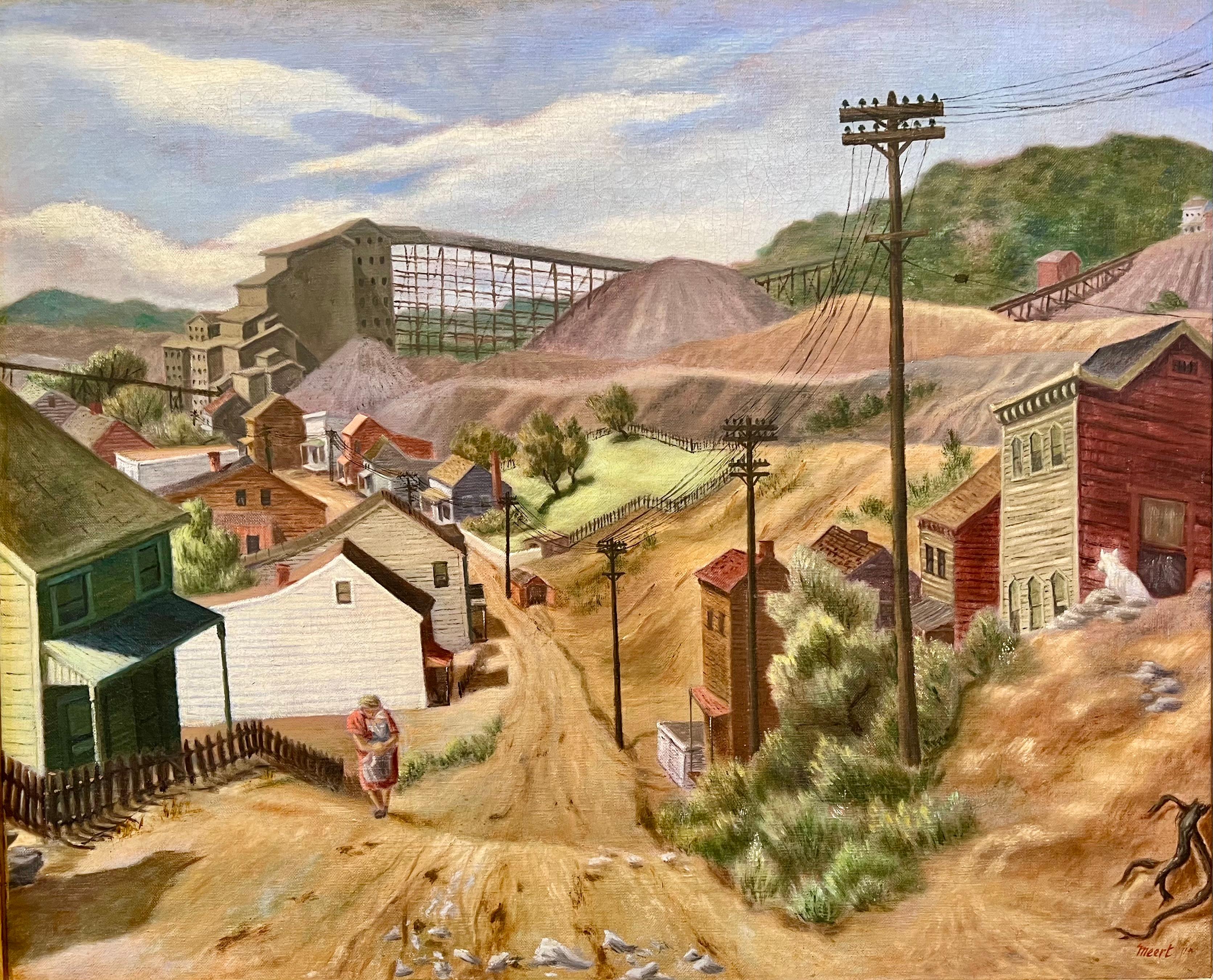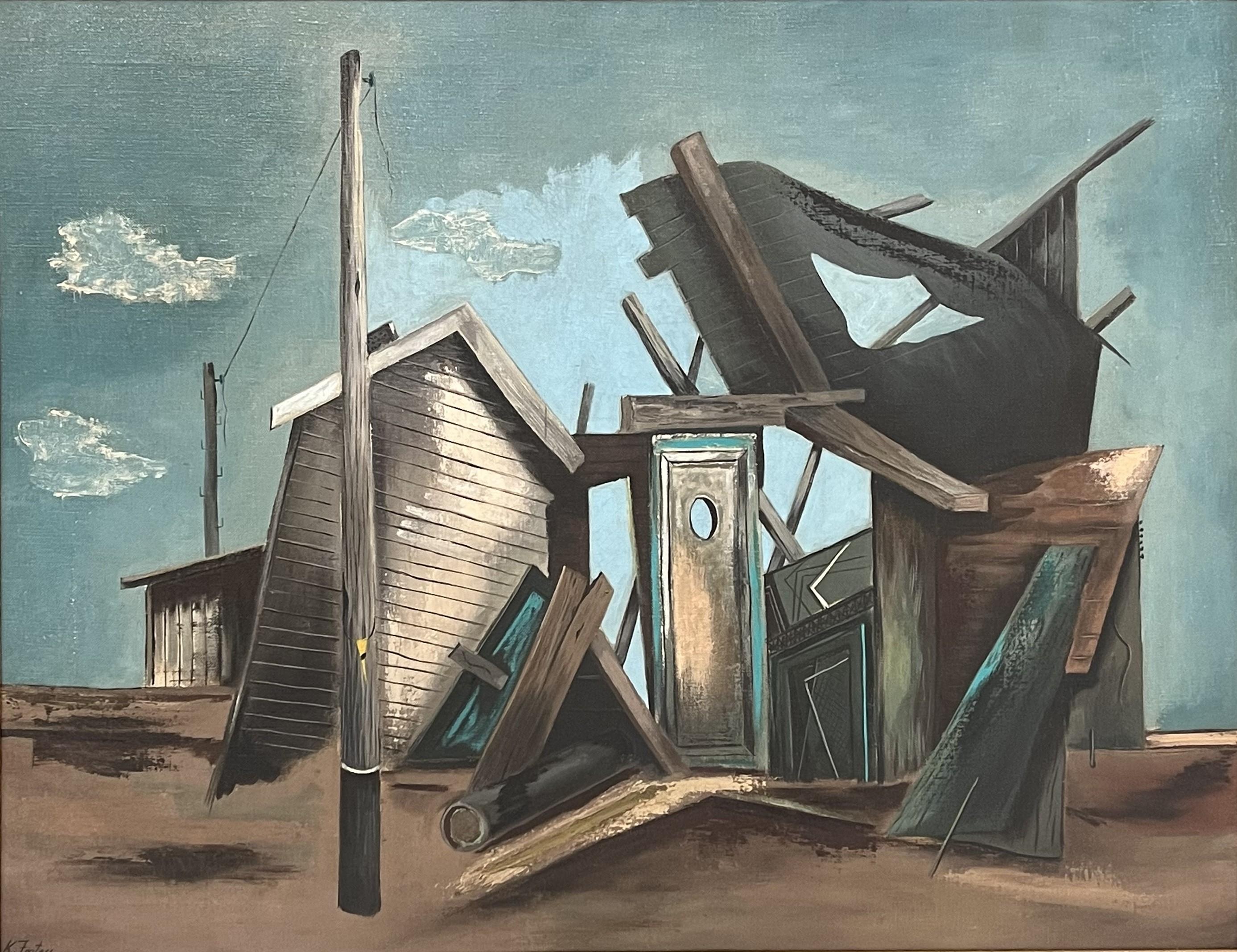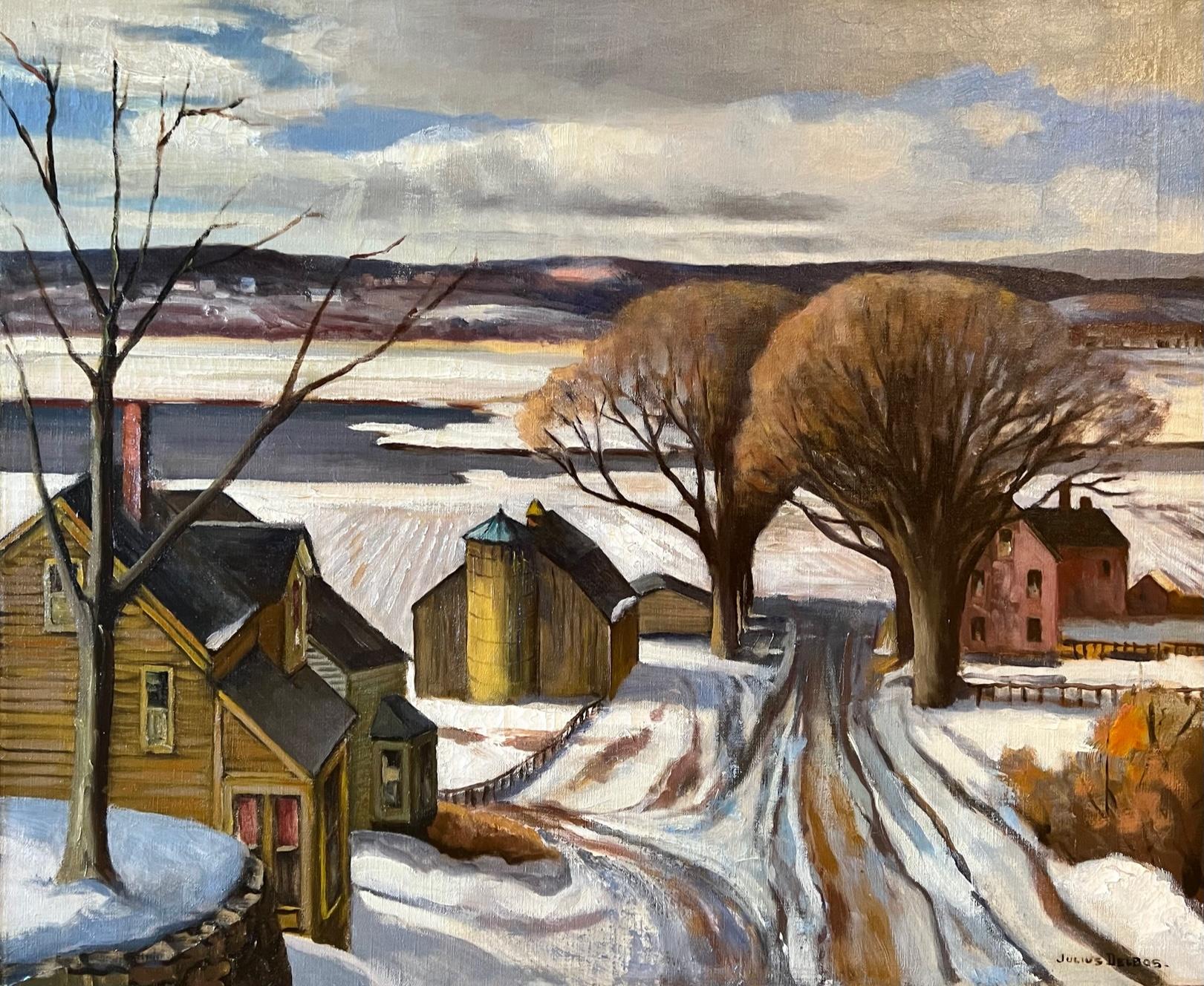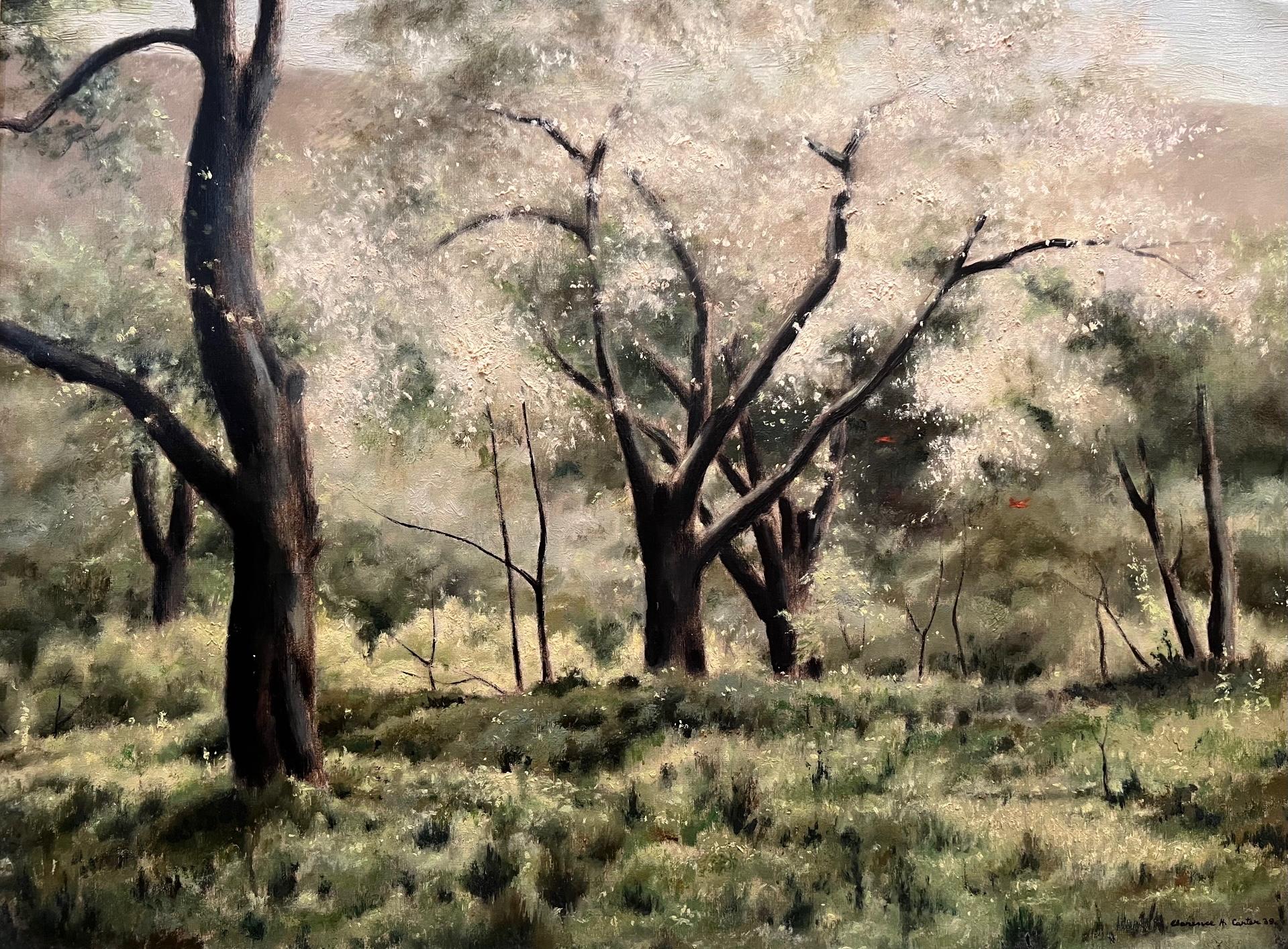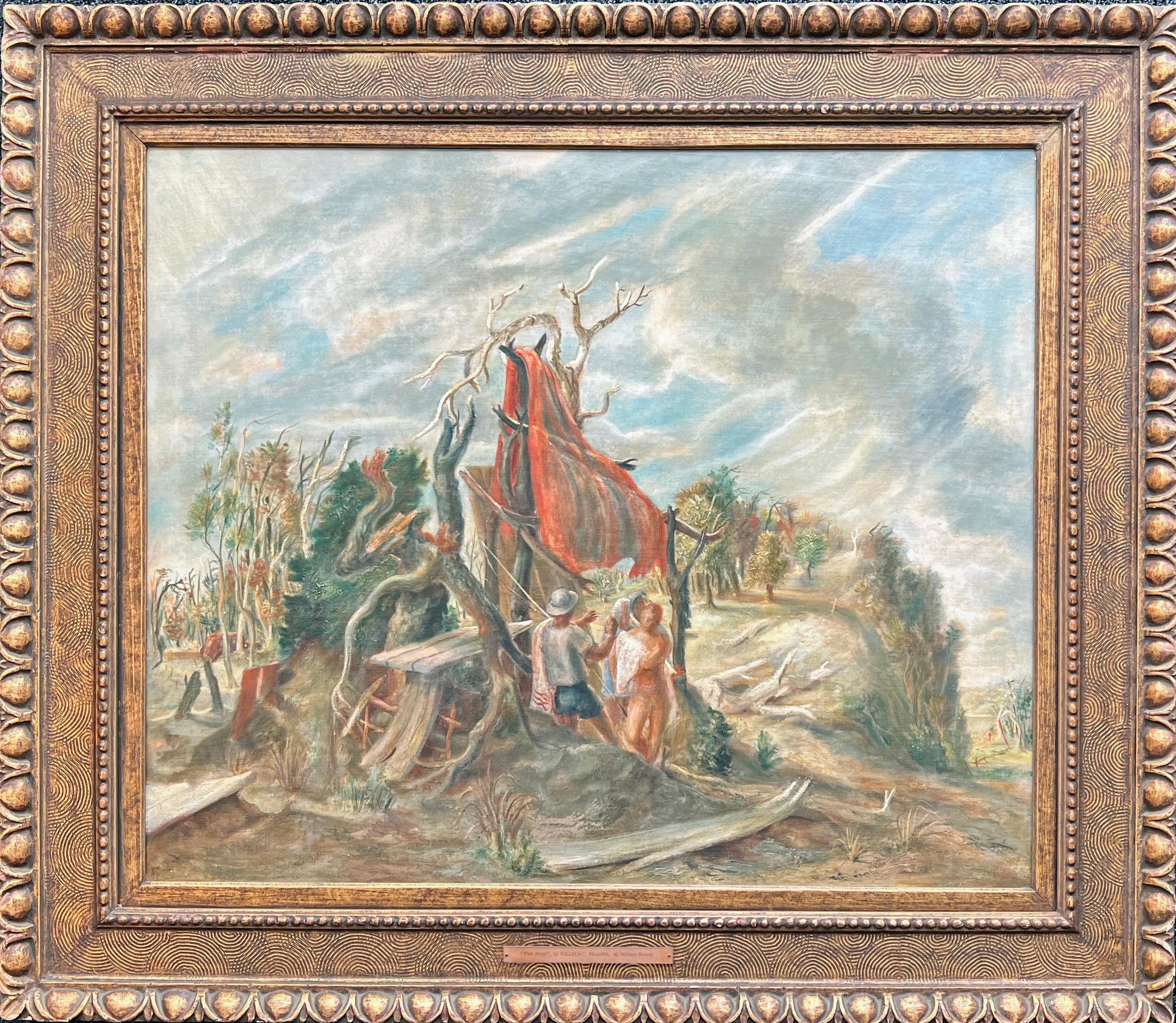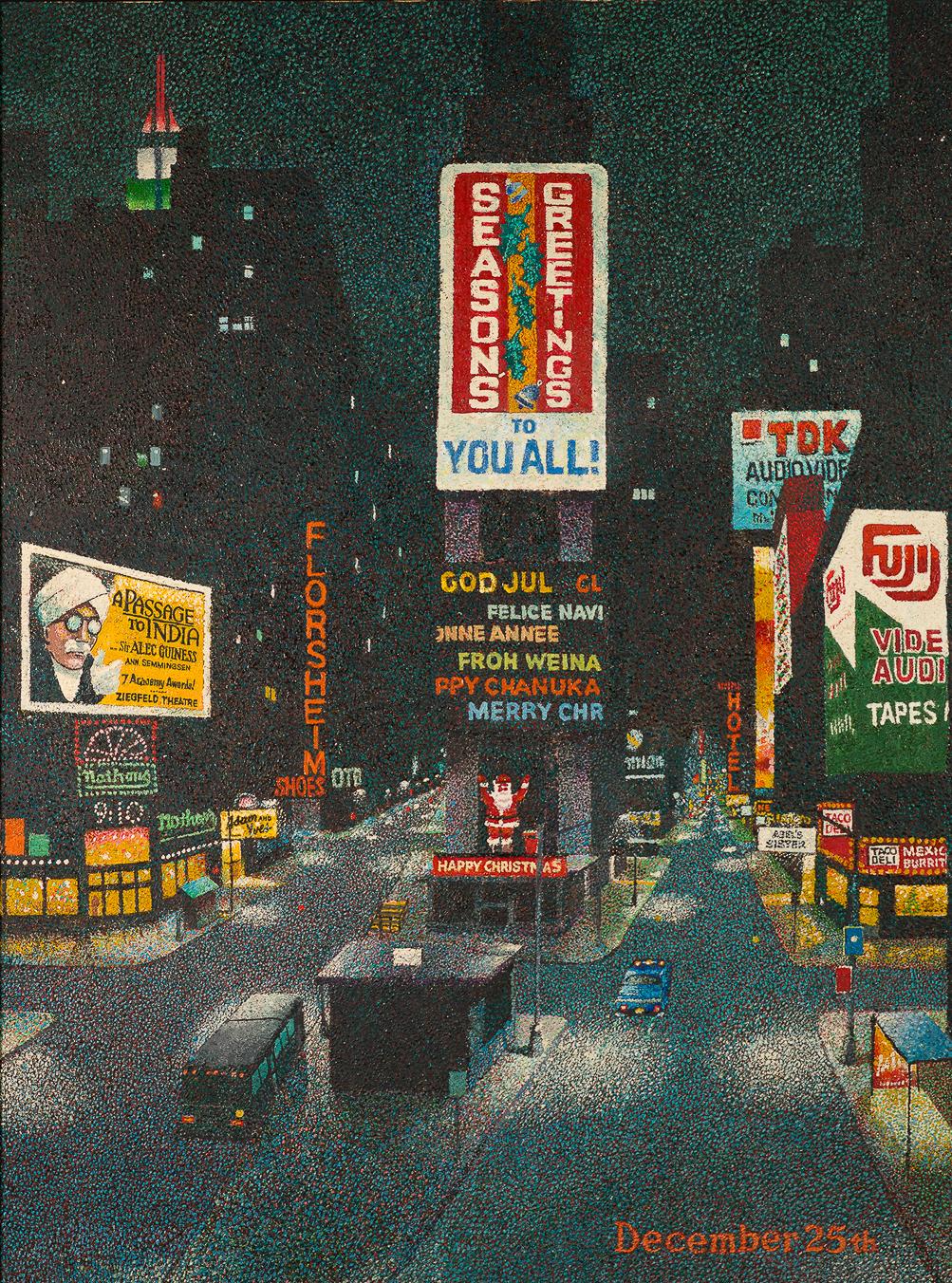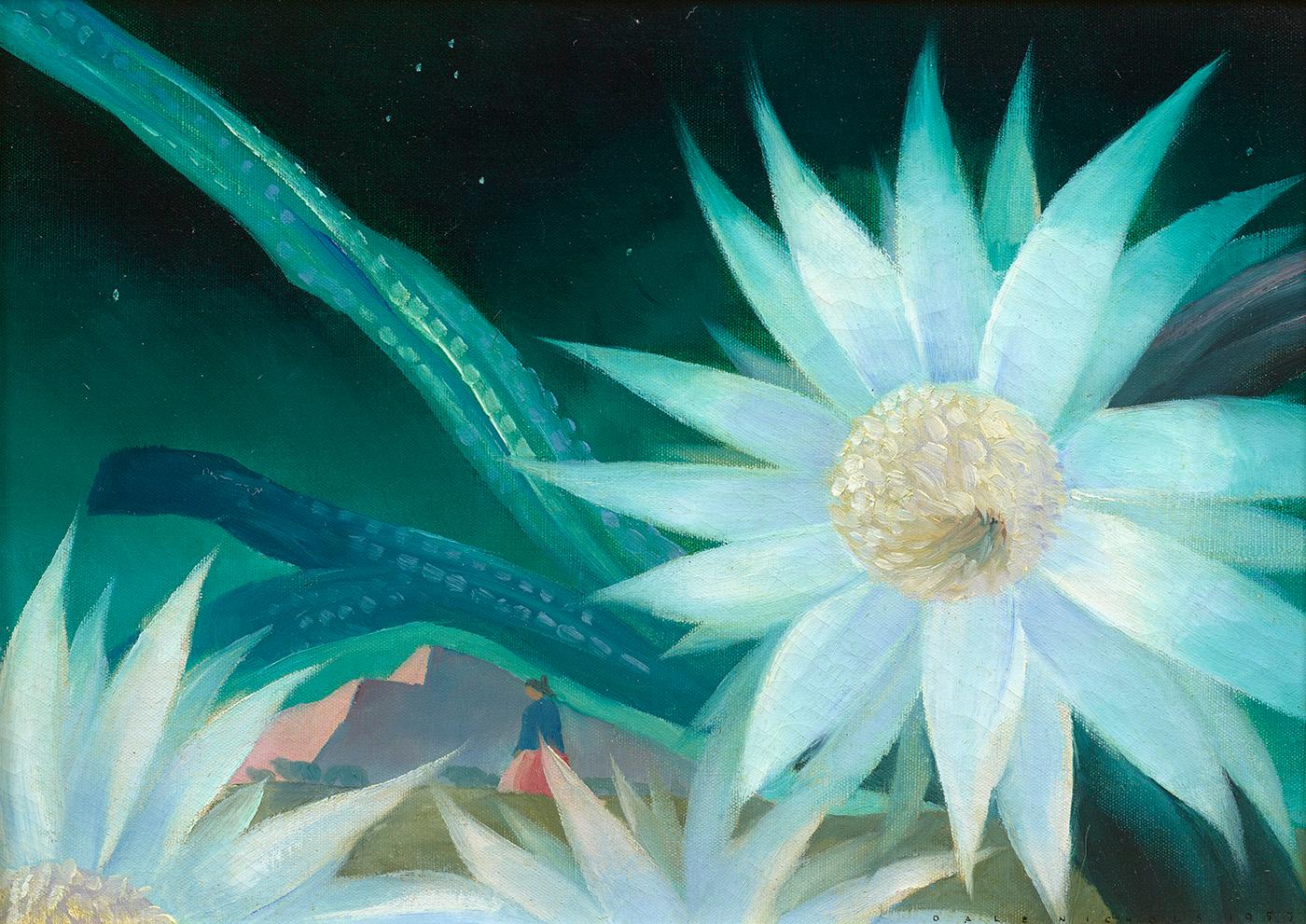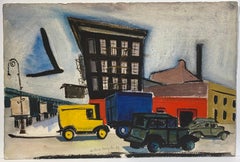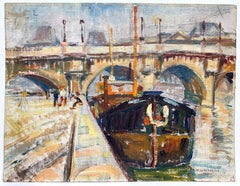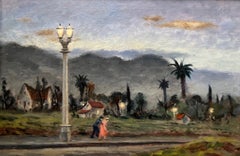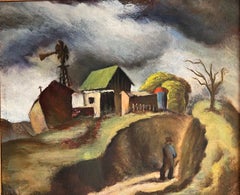Moonrise
View Similar Items
Want more images or videos?
Request additional images or videos from the seller
1 of 10
Yarnall AbbottMoonrise1930s
1930s
About the Item
- Creator:Yarnall Abbott (1870 - 1938, American)
- Creation Year:1930s
- Dimensions:Height: 28 in (71.12 cm)Width: 23 in (58.42 cm)Depth: 2 in (5.08 cm)
- Medium:
- Movement & Style:
- Period:
- Condition:
- Gallery Location:Wilton Manors, FL
- Reference Number:1stDibs: LU24521167773
About the Seller
4.9
Gold Seller
These expertly vetted sellers are highly rated and consistently exceed customer expectations.
Established in 2007
1stDibs seller since 2015
328 sales on 1stDibs
Typical response time: 9 hours
More From This SellerView All
- North on West Street (West Side Highway NYC Cityscape)By De Hirsch MargulesLocated in Wilton Manors, FLDe Hirsh Margules (1899-1965). North on West Street , 1939. Watercolor on Arches wove paper. Signed and dated in pencil by artist lower margin. Sheet measures 15 x 22 inches. Framed measurement: 27 x 34 inched. Incredibly vibrant and saturated color with no fading or toning of sheet. Provenance: Babcock Galleries, NYC De Hirsh Margules (1899–1965) was a Romanian-American "abstract realist" painter who crossed paths with many major American artistic and intellectual figures of the first half of the 20th century. Elaine de Kooning said that he was "[w]idely recognized as one of the most gifted and erudite watercolorists in the country". The New York Times critic Howard Devree stated in 1938 that "Margules uses color in a breath-taking manner. A keen observer, he eliminates scrupulously without distortion of his material." Devree later called Margules "one of our most daring experimentalists in the medium" Margules was also a well-known participant in the bohemian culture of New York City's Greenwich Village, where he was widely known as the "Baron" of Greenwich Village.[1] The New York Times described him as "one of Greenwich Village's best-known personalities" and "one of the best known and most buoyant characters about Greenwich Village. Early Life De Hirsh Margules was born in 1899 in the Romanian city of Iași (also known as Iasse, Jassy, or Jasse). When Margules was 10 weeks old, his family immigrated to New York City. Both of his parents were active in the Yiddish theater, His father was Yekutiel "Edward" Margules, a "renowned Jewish actor-impresario and founder of the Yiddish stage." Margules' mother, Rosa, thirty-nine years younger than his father, was an actress in the Yiddish theater and later in vaudeville. Although Margules appeared as a child actor with the Adler Family[11] and Bertha Kalich, his sister, Annette Margules, somewhat dubiously continued in family theater and vaudeville tradition, creating the blackface role of the lightly-clad Tondelayo (a part later played on film Hedy Lamarr) in Earl Carroll's 1924 Broadway exoticist hit, White Cargo. Annette herself faced stereotyping as an exotic flower: writing about her publicist Charles Bouchert stated that "Romania produces a stormy, temperamental type of woman---a type admirably fitted to portray emotion." His brother Samuel became a noted magician who appeared under the name "Rami-Sami." Samuel later became a lawyer, representing magician Horace Goldin, among others. A family portrait including a young De Hirsh, a portrait of Rosa and Annette together, and individual photos of Rosa and Edward can be found on the Museum of the City of New York website. At around age 9 or 10, Margules took art classes with the Boys Club on East Tenth Street, and his first taste of exhibition was at a student art show presented by the club. By age 11, he had won a city-wide prize (a box camera) at a children's art show presented by the department store Wanamakers. As a young teenager, Margules was already displaying a characteristic kindness and loyalty. Upon hearing that two friends (one of them was author Alexander King), were in trouble for breaking a school microscope, the nearly broke Margules gave them five dollars to repair the microscope . Margules had to approach a wealthy man that Margules had once saved on the subway from a heart attack. Margules didn't reveal the source of the five dollars to King until twenty-five years later. In his late teens, Margules studied for a couple of months in Pittsburgh with Edwin Randby, a follower of Western painter Frederic Remington. Thereafter he pursued a two-year course of studies in architecture, design and decoration at the New York Evening School of Art and Design, while working as a clerk during the day at Stern's Department Store. He was encouraged in these artistic pursuits by his neighbor, the painter Benno Greenstein (who later went by the name of Benjamin Benno). Artistic career In 1922, Margules began work as a police reporter for the City News Association of New York .Margules then considered himself something of an expert on art, and the painter Myron Lechay is said to have responded to some unsolicited analysis of his work with the remark "Since you seem to know so much about it, why don't you paint yourself?" This led to study with Lechay and a flurry of painting. Margules' first show was in 1922 at Jane Heap's Little Review Gallery. Thereafter Margules began to participate in shows with a group including Stuart Davis, Jan Matulka, Buckminster Fuller (exhibiting depictions of his "Dymaxion house") in a gallery run by art-lover and restaurateur Romany Marie on the floor above her cafe. Jane Heap, left, with Mina Loy and Ezra Pound During the 1920s, Margules traveled outside of the country a number of times. In 1922, with the intent of reaching Bali, he took a job as a "'wiper on a tramp steamer where [he] played nursemaid to the engine." He reached Rotterdam before he turned back. He would return to Rotterdam shortly thereafter. In 1927, Margules took a lengthy leave of absence from his day job as a police reporter in order to travel to Paris, where he "set up a studio in Montmartre's Place du Tertre, on the top floor of an almost deserted hotel, a shabby establishment, lacking both heat and running water." He studied at the Louvre and traveled to paint landscapes in provincial France and North Africa. Margules also joined the "Noctambulist" movement and experimented with painting and showing his artwork in low light.Jonathan Cott wrote that: the painter De Hirsch Margulies sat on the quays of the Seine and painted pictures in the dark. In fact, the first exhibition of these paintings, which could be seen only in a darkened room, took place in [ Walter Lowenfels'] Paris apartment. Elaine de Kooning remarked that studying the works of the Noctambulists confirmed Margules' "direction toward the use of primary colors for perverse effects of heavy shadow." It was also in Paris that Margules initially conceived his idea of "Time Painting", where a painting is divided into sectors, each representing a different time of day, with color choices meant to evoke that time of day. In Paris, his social circle included Lowenfels, photographer Berenice Abbott, publisher Jane Heap, composer George Anthiel, sculptor Thelma Wood, painter André Favory, writer Norman Douglas, writer and editor George Davis, composer and writer Max Ewing, and writer Michael Fraenkel. Upon his return to New York in 1929, Margules attended an exhibition of John Marin's paintings. While at the exhibition, he "launched into an eloquent explanation of Marin to two nearby women", and was overheard by an impressed Alfred Stieglitz. The famous photographer and art promoter invited Margules to dine with his wife, the artist Georgia O'Keeffe, and his assistant, painter Emil Zoler. Stieglitz thereafter became a friend and mentor to Margules, becoming for him "what Socrates was to his friends." Alfred Stieglitz Stieglitz introduced Margules to John Marin, who quickly became the most important painterly influence upon Margules. Elaine de Kooning later noted that Margules was "indebted to Marin and through Marin to Cézanne for his initial conceptual approach - for his constructions of scenes with no negative elements, for skies that loom with the impact of mountains." Margules himself said that Marin was his "father and ... academy." The admiration was by no means unreciprocated: Marin said that Margules was "an art lover with abounding faith and sincerity, with much intelligence and quick seeing." Stieglitz also introduced Margules to many other artistic and intellectual figures in New York. With the encouragement of Alfred Stieglitz, Margules in 1936 opened a two-room gallery at 43 West 8th Street called "Another Place." Over the following two years there were fourteen solo exhibitions by Margules and others, and the gallery was well-respected by the press. It was in this gallery that the painter James Lechay, Myron's brother, exhibited his first painting. In 1936, Margules first saw recognition by major art museums when both the Museum of Modern Art and the Museum of Fine Arts, Boston purchased his works. In 1942, Margules gave up working as a police reporter, and apparently dedicated himself thereafter solely to an artistic vocation. "The Baron of Greenwich Village"[edit] Margules made his mark not only as an artist, but also as an outsized personality known throughout Greenwich Village and beyond. To local residents, Margules was known as the "Baron", after Baron Maurice de Hirsch, a prominent German Jewish philanthropist. Margules was easily recognizable by the beret he routinely wore over his long hair. Writer Charles Norman said that he "dressed with a flair for sloppiness." He was said to "know everybody" in Greenwich Village, to the extent that when the novelist and poet Maxwell Bodenheim was murdered, Margules was the first one the police sought to identify the body. Margules' letters show him interacting with art world figures such as Sacha Kolin, John Marin and Alfred Stieglitz, as well as with prominent figures outside the art world such as polymath Buckminster Fuller and writer Henry Miller. Most of his friends and acquaintances found Margules a generous and voluble man, given to broadly emotionally expressive gestures and acts of kindness and loyalty. In 1929, he exhibited an example of this loyalty and fellow-feeling when he appeared in court to fight what the wrongful commitment of his friend, writer and sculptor Alfred Dreyfuss, who appeared to have been a victim of an illicit attempt to block an inheritance. The Greenwich Village chronicler Charles Norman described the bone-crushing hugs that Margules would routinely bestow on his friends and acquaintances, and speaks of the "persuasive theatricality" that Margules seemed to have inherited from his actor parents. Norman also wrote about Margules' routine acts of kindness, taking in homeless artists, constantly feeding his friends and providing the salvatory loan where needed. Norman also notes that Margules was blessed with a loud and good voice, and was apt to sing an operatic air without provocation. The writer and television personality Alexander King said I think the outstanding characteristics of my friend's personality are affirmation, emphasis, and overemphasis. He chooses to express himself predominantly in superlatives and the gestures which accompany his utterances are sometimes dangerous to life and limb. Of the bystanders, I mean. King also spoke with affectionate amusement about Margules' pride in his cooking, speaking of how "if he should ever invite you to dinner, he may serve you a hamburger with onions, in his kitchen-living room, with such an air of gastronomic protocol, such mysterious hints and ogliing innuendoes, as if César Ritz and Brillat-Savarin had sneaked out, only a moment before, with his secret recipe in their pockets." Margules was such a memorable New York personality that comic book writer Alvin Schwartz imagined him at the Sixth Avenue Cafeteria in a risible yet poignant debate with Clark Kent about whether Superman had the ability to stop Hitler. Margules' entrenchment in the Greenwich Village milieu can be seen in a photograph from Fred McDarrah's "Beat Generation Album" of a January 13, 1961 writers' and poets' meeting to discuss "The Funeral of the Beat Generation", in Robert Cordier [fr]'s railroad flat at 85 Christopher Street. Among the people in the same photograph are Shel Silverstein...Category
1930s American Modern Abstract Paintings
MaterialsWatercolor, Rag Paper
$6,000 Sale Price20% Off - Christopher Street (abstract Greenwich Village cityscape)By De Hirsch MargulesLocated in Wilton Manors, FLDe Hirsh Margules (1899-1965). Christopher Street, 1939. Watercolor on Arches wove paper. Signed and dated in pencil by artist lower margin. Sheet measures 15.5 x 20 inches. Window in matting measures 15 x 19 inches. Framed measurement: 23 x 30 inched. Bears fragment of original label affixed on verso. Incredibly vibrant and saturated color with no fading or toning of sheet. Provenance: Babcock Galleries, NYC Exhibited: The American Federation of Arts Traveling Exhibition. From the facade of The Waverly at Christopher is depicted One Christopher Street, the 16-story Art Deco residential building erected in 1931. It is not a casual coincidence that the structure appears in this cityscape: 1 Christopher Street is the subject. The original intention of this project was to transform the neighborhood, bring a bit of affluence and make a bid to rival the Upper West Side. Margules, a sensitive aesthete, understood how a massive piece of architecture such as One changes a neighborhood. Sound, scale and focal points are forever altered. A pedestrian's sense of depth and distance becomes pronounced. All of these factors contribute to the intent behind this image. Tall buildings disrupt the human scale, change the skyline and carve up space. In this piece, negative space conforms to the man-made geometries. Clouds become gems fixed in settings. De Hirsh Margules (1899–1965) was a Romanian-American "abstract realist" painter who crossed paths with many major American artistic and intellectual figures of the first half of the 20th century. Elaine de Kooning said that he was "[w]idely recognized as one of the most gifted and erudite watercolorists in the country". The New York Times critic Howard Devree stated in 1938 that "Margules uses color in a breath-taking manner. A keen observer, he eliminates scrupulously without distortion of his material." Devree later called Margules "one of our most daring experimentalists in the medium" Margules was also a well-known participant in the bohemian culture of New York City's Greenwich Village, where he was widely known as the "Baron" of Greenwich Village.[1] The New York Times described him as "one of Greenwich Village's best-known personalities" and "one of the best known and most buoyant characters about Greenwich Village. Early Life De Hirsh Margules was born in 1899 in the Romanian city of Iași (also known as Iasse, Jassy, or Jasse). When Margules was 10 weeks old, his family immigrated to New York City. Both of his parents were active in the Yiddish theater, His father was Yekutiel "Edward" Margules, a "renowned Jewish actor-impresario and founder of the Yiddish stage." Margules' mother, Rosa, thirty-nine years younger than his father, was an actress in the Yiddish theater and later in vaudeville. Although Margules appeared as a child actor with the Adler Family[11] and Bertha Kalich, his sister, Annette Margules, somewhat dubiously continued in family theater and vaudeville tradition, creating the blackface role of the lightly-clad Tondelayo (a part later played on film Hedy Lamarr) in Earl Carroll's 1924 Broadway exoticist hit, White Cargo. Annette herself faced stereotyping as an exotic flower: writing about her publicist Charles Bouchert stated that "Romania produces a stormy, temperamental type of woman---a type admirably fitted to portray emotion." His brother Samuel became a noted magician who appeared under the name "Rami-Sami." Samuel later became a lawyer, representing magician Horace Goldin, among others. A family portrait including a young De Hirsh, a portrait of Rosa and Annette together, and individual photos of Rosa and Edward can be found on the Museum of the City of New York website. At around age 9 or 10, Margules took art classes with the Boys Club on East Tenth Street, and his first taste of exhibition was at a student art show presented by the club. By age 11, he had won a city-wide prize (a box camera) at a children's art show presented by the department store Wanamakers. As a young teenager, Margules was already displaying a characteristic kindness and loyalty. Upon hearing that two friends (one of them was author Alexander King), were in trouble for breaking a school microscope, the nearly broke Margules gave them five dollars to repair the microscope . Margules had to approach a wealthy man that Margules had once saved on the subway from a heart attack. Margules didn't reveal the source of the five dollars to King until twenty-five years later. In his late teens, Margules studied for a couple of months in Pittsburgh with Edwin Randby, a follower of Western painter Frederic Remington. Thereafter he pursued a two-year course of studies in architecture, design and decoration at the New York Evening School of Art and Design, while working as a clerk during the day at Stern's Department Store. He was encouraged in these artistic pursuits by his neighbor, the painter Benno Greenstein (who later went by the name of Benjamin Benno). Artistic career In 1922, Margules began work as a police reporter for the City News Association of New York .Margules then considered himself something of an expert on art, and the painter Myron Lechay is said to have responded to some unsolicited analysis of his work with the remark "Since you seem to know so much about it, why don't you paint yourself?" This led to study with Lechay and a flurry of painting. Margules' first show was in 1922 at Jane Heap's Little Review Gallery. Thereafter Margules began to participate in shows with a group including Stuart Davis, Jan Matulka, Buckminster Fuller (exhibiting depictions of his "Dymaxion house") in a gallery run by art-lover and restaurateur Romany Marie on the floor above her cafe. Jane Heap, left, with Mina Loy and Ezra Pound During the 1920s, Margules traveled outside of the country a number of times. In 1922, with the intent of reaching Bali, he took a job as a "'wiper on a tramp steamer where [he] played nursemaid to the engine." He reached Rotterdam before he turned back. He would return to Rotterdam shortly thereafter. In 1927, Margules took a lengthy leave of absence from his day job as a police reporter in order to travel to Paris, where he "set up a studio in Montmartre's Place du Tertre, on the top floor of an almost deserted hotel, a shabby establishment, lacking both heat and running water." He studied at the Louvre and traveled to paint landscapes in provincial France and North Africa. Margules also joined the "Noctambulist" movement and experimented with painting and showing his artwork in low light.Jonathan Cott wrote that: the painter De Hirsch Margulies sat on the quays of the Seine and painted pictures in the dark. In fact, the first exhibition of these paintings, which could be seen only in a darkened room, took place in [ Walter Lowenfels'] Paris apartment. Elaine de Kooning remarked that studying the works of the Noctambulists confirmed Margules' "direction toward the use of primary colors for perverse effects of heavy shadow." It was also in Paris that Margules initially conceived his idea of "Time Painting", where a painting is divided into sectors, each representing a different time of day, with color choices meant to evoke that time of day. In Paris, his social circle included Lowenfels, photographer Berenice Abbott, publisher Jane Heap, composer George Anthiel, sculptor Thelma Wood, painter André Favory, writer Norman Douglas, writer and editor George Davis, composer and writer Max Ewing, and writer Michael Fraenkel. Upon his return to New York in 1929, Margules attended an exhibition of John Marin's paintings. While at the exhibition, he "launched into an eloquent explanation of Marin to two nearby women", and was overheard by an impressed Alfred Stieglitz. The famous photographer and art promoter invited Margules to dine with his wife, the artist Georgia O'Keeffe, and his assistant, painter Emil Zoler. Stieglitz thereafter became a friend and mentor to Margules, becoming for him "what Socrates was to his friends." Alfred Stieglitz Stieglitz introduced Margules to John Marin, who quickly became the most important painterly influence upon Margules. Elaine de Kooning later noted that Margules was "indebted to Marin and through Marin to Cézanne for his initial conceptual approach - for his constructions of scenes with no negative elements, for skies that loom with the impact of mountains." Margules himself said that Marin was his "father and ... academy." The admiration was by no means unreciprocated: Marin said that Margules was "an art lover with abounding faith and sincerity, with much intelligence and quick seeing." Stieglitz also introduced Margules to many other artistic and intellectual figures in New York. With the encouragement of Alfred Stieglitz, Margules in 1936 opened a two-room gallery at 43 West 8th Street called "Another Place." Over the following two years there were fourteen solo exhibitions by Margules and others, and the gallery was well-respected by the press. It was in this gallery that the painter James Lechay, Myron's brother, exhibited his first painting. In 1936, Margules first saw recognition by major art museums when both the Museum of Modern Art and the Museum of Fine Arts, Boston purchased his works. In 1942, Margules gave up working as a police reporter, and apparently dedicated himself thereafter solely to an artistic vocation. "The Baron of Greenwich Village"[edit] Margules made his mark not only as an artist, but also as an outsized personality known throughout Greenwich Village and beyond. To local residents, Margules was known as the "Baron", after Baron Maurice de Hirsch, a prominent German Jewish philanthropist. Margules was easily recognizable by the beret he routinely wore over his long hair. Writer Charles Norman said that he "dressed with a flair for sloppiness." He was said to "know everybody" in Greenwich Village, to the extent that when the novelist and poet Maxwell Bodenheim was murdered, Margules was the first one the police sought to identify the body. Margules' letters show him interacting with art world figures such as Sacha Kolin, John Marin and Alfred Stieglitz, as well as with prominent figures outside the art world such as polymath Buckminster Fuller and writer Henry Miller. Most of his friends and acquaintances found Margules a generous and voluble man, given to broadly emotionally expressive gestures and acts of kindness and loyalty. In 1929, he exhibited an example of this loyalty and fellow-feeling when he appeared in court to fight what the wrongful commitment of his friend, writer and sculptor Alfred Dreyfuss, who appeared to have been a victim of an illicit attempt to block an inheritance. The Greenwich Village chronicler Charles Norman described the bone-crushing hugs that Margules would routinely bestow on his friends and acquaintances, and speaks of the "persuasive theatricality" that Margules seemed to have inherited from his actor parents. Norman also wrote about Margules' routine acts of kindness, taking in homeless artists, constantly feeding his friends and providing the salvatory loan where needed. Norman also notes that Margules was blessed with a loud and good voice, and was apt to sing an operatic air without provocation. The writer and television personality Alexander King said I think the outstanding characteristics of my friend's personality are affirmation, emphasis, and overemphasis. He chooses to express himself predominantly in superlatives and the gestures which accompany his utterances are sometimes dangerous to life and limb. Of the bystanders, I mean. King also spoke with affectionate amusement about Margules' pride in his cooking, speaking of how "if he should ever invite you to dinner, he may serve you a hamburger with onions, in his kitchen-living room, with such an air of gastronomic protocol, such mysterious hints and ogliing innuendoes, as if César Ritz and Brillat-Savarin had sneaked out, only a moment before, with his secret recipe in their pockets." Margules was such a memorable New York personality that comic book writer Alvin Schwartz imagined him at the Sixth Avenue Cafeteria in a risible yet poignant debate with Clark Kent about whether Superman had the ability to stop Hitler. Margules' entrenchment in the Greenwich Village milieu can be seen in a photograph from Fred McDarrah's "Beat Generation Album" of a January 13, 1961 writers' and poets' meeting to discuss "The Funeral of the Beat Generation", in Robert Cordier [fr]'s railroad flat at 85 Christopher Street. Among the people in the same photograph are Shel Silverstein...Category
1930s American Modern Abstract Paintings
MaterialsWatercolor, Rag Paper
$6,000 Sale Price20% Off - Pont Neuf Paris France (bridge cityscape/ landscape double-sided painting)Located in Wilton Manors, FLMieczyslaw Lurczynski (1908-1992). Pont Neuf/ Landscape. Double-sided canvas measures 10.5 x 13.75 inches. Canvas is a gessoed panel, unstretched. Signed lower right.Category
Mid-20th Century Fauvist Landscape Paintings
MaterialsOil, Canvas
- October Fog (West Chester, Chester County PA Landscape)Located in Wilton Manors, FLBarclay Rubincam (1920-1978). October Fog, 1966. Oil on canvas, 20 x 40 inches; 23.5 x 43.5 inches framed. Signed and dated lower right. Original label affixed verso. Excellent condition. original frame. Barclay Rubincam (1920-1978) was born and grew up in Chester County, Pennsylvania, where he developed a life-long love for its charming landscape and fascinating history. Art was an early passion, and Rubincam spent hours drawing and painting murals, posters, and other decorations and projects during his school years. After graduating from Unionville High School in 1939, he attended the Wilmington Academy of Fine Arts (today the Delaware Art Museum) where he was taught by Gale Hoskins and Frank Schoonover, among others. He also studied with N.C. Wyeth in Chadds Ford. Army service during World War II delayed the start of Rubincam's professional career as a painter, but when he returned from duty, he set up a studio in his newly purchased house in West Chester...Category
Mid-20th Century American Realist Landscape Paintings
MaterialsCanvas, Oil
$3,250 Sale Price35% Off - Casas de Ibiza (Ibiza Spain Landscape)By Enrique ClimentLocated in Wilton Manors, FLEnrique Climent (1897-1980). Casas de Ibiza, c.1960. Oil and sand on canvas, 35 x 46 inches; 44.5 x 55.5 inches (frame). Signed lower left. Excellent condition with no damage or conservation. Instituo National de Bellas Artes lebel affixed en verso. Biography: Enrique Climent ( Valencia , Spain, 1897- Mexico City , 1980) was a Spanish painter and graphic designer, present in the Spanish Pavilion of the International Exhibition of Paris in 1937 , two of whose works are conserved in the National Museum Art Center Reina Sofía , as part of the collection of the Spanish Museum of Contemporary Art (MEAC). Exiled in Mexico , country in which he died at 83 years of age. He has been associated with the driving group in Spain of the "New Art". Born in a bourgeois family of the Valencian capital, despite paternal opposition, Climent studied at the School of Fine Arts of San Carlos , and with a scholarship received in 1919, traveled to Madrid to complete them in San Fernando . In the capital of Spain he participated in the gathering of Ramón Gómez de la Serna , for whom he illustrated some greguerías , and in the avant-garde activities of the then-called first Escuela de Vallecas , Associated with the Society of Iberian Artists . He also collaborated as an illustrator of Blanco y Negro magazine, 3 and illustrated books by Elena Fortún , Azorín , Juan Manuel Díaz Caneja and Manuel Abril . 3 Before, in 1924 he had been in Paris for two years, where he came to design some stage sets for opera shows. 6 He participated in three of the exhibitions of "Los Ibéricos" (San Sebastián in 1931, Copenhagen in 1932 and Berlin in 1933), as well as in the International Exhibitions of Contemporary Spanish Art in Paris and Venice in 1936. He was one of the Spanish exiles who in 1939 landed in Veracruz , after the crossing of the Sinaia , along with other intellectuals and artists (such as José Moreno Villa , Arturo Souto...Category
Mid-20th Century Abstract Landscape Paintings
MaterialsCanvas, Oil
$15,000 Sale Price25% Off - Perugia, Italy LandscapeLocated in Wilton Manors, FLBobert Brown (British, b.1936). Perugia, Italy. Oil on canvas measures 14.5 x 22 inches; 19.5 x 27 inches framed. Signed lower left. One faint area of scratching on paint surface in ...Category
1980s Realist Landscape Paintings
MaterialsCanvas, Oil
$880 Sale Price20% Off
You May Also Like
- Six O'ClockLocated in Los Angeles, CASix O-Clock, c. 1942, oil on canvas, 30 x 20 inches, signed and titled several times verso of frame and stretcher (perhaps by another hand), marked “Rehn” several times on frame (for the Frank K. M. Rehn Galleries in New York City, who represented Craig at the time); Exhibited: 1) 18th Biennial Exhibition of Contemporary American Oil Paintings from March 21 to May 2, 1943 at The Corcoran Gallery of Art in Washington, D.C. #87, original price $450 (per catalog) (exhibition label verso), 2) Craig’s one-man show at the Frank K. M. Rehn Galleries, New York City, from October 26 to November 14, 1942, #10 (original price listed as $350); and 3) Exhibition of thirty paintings sponsored by the Harrisburg Art Association at the State Museum of Pennsylvania in Harrisburg in March, 1944 (concerning this exhibit, Penelope Redd of The Evening News (Harrisburg, Pennsylvania) wrote: “Other paintings that have overtones of superrealism inherent in the subjects include Tom Craig’s California nocturne, ‘Six O’Clock,’ two figures moving through the twilight . . . .” March 6, 1944, p. 13); another label verso from The Museum of Art of Toledo (Ohio): original frame: Provenance includes George Stern Gallery, Los Angeles, CA About the Painting Long before Chris Burden’s iconic installation outside of the Los Angeles County Museum of Art, Urban Light, another artist, Tom Craig, made Southern California streetlights the subject of one of his early 1940s paintings. Consisting of dozens of recycled streetlights from the 1920s and 1930s forming a classical colonnade at the museum’s entrance, Burden’s Urban Light has become a symbol of Los Angeles. For Burden, the streetlights represent what constitutes an advanced society, something “safe after dark and beautiful to behold.” It seems that Craig is playing on the same theme in Six O-Clock. Although we see two hunched figures trudging along the sidewalk at the end of a long day, the real stars of this painting are the streetlights which brighten the twilight and silhouette another iconic symbol of Los Angeles, the palm trees in the distance. Mountains in the background and the distant view of a suburban neighborhood join the streetlights and palm trees as classic subject matter for a California Scene painting, but Craig gives us a twist by depicting the scene not as a sun-drenched natural expanse. Rather, Craig uses thin layers of oil paint, mimicking the watercolor technique for which he is most famous, to show us the twinkling beauty of manmade light and the safety it affords. Although Southern California is a land of natural wonders, the interventions of humanity are already everywhere in Los Angeles and as one critic noted, the resulting painting has an air of “superrealism.” About the Artist Thomas Theodore Craig was a well-known fixture in the Southern California art scene. He was born in Upland California. Craig graduated with a degree in botany from Pomona College and studied painting at Pamona and the Chouinard Art School with Stanton MacDonald-Wright and Barse Miller among others. He became close friends with fellow artist Milford Zornes...Category
1940s American Modern Landscape Paintings
MaterialsCanvas, Oil
$12,500 - LandscapeBy Marcel Emile CaillietLocated in Los Angeles, CALandscape, 1940, oil on canvas, 24 x 20 inches, signed, dated and titled verso: “Marcel Cailliet ’40 – S.C.” and “Marcel Cailliet Landscape”; likely exhibited at the annual juried st...Category
1940s American Modern Paintings
MaterialsCanvas, Oil
- Gold Mine, Central City, ColoradoBy Joseph MeertLocated in Los Angeles, CAThis painting is part of our exhibition America Coast to Coast: Artists of the 1930s Goldmine, Central City, Colorado, oil on canvas, 36 x 28 inches, c. 1936, signed lower right, ex collection of Platt Fine Art, Chicago, Illinois (label verso). About the Painting Joseph Meert’s painting, Goldmine, Central City, Colorado, depicts the short-lived resurrection of a once prominent city just outside Denver. Central City was founded in 1859 soon after John Gregory struck gold in the area. As word spread, thousands of miners converged into “Gregory’s Gulch” and its surroundings became known as the “richest square mile on earth.” Mining production quickly increased resulting in Central City to becoming Colorado’s largest city in the early 1860s. Despite some technical difficulties transitioning to lode mining and the rise of competition from Leadville, Central City remained an economic boom town through the turn of the century. But, with every boom, there is a bust. World War I marked the end of Central City’s prominence as ore production ground to a halt and by 1925, the town’s population shrank to only 400 people. The desperation of the Great Depression and a nearly 100% increase in the price of gold lured labor and capital back to Central City. Meert painted in Colorado during the mid-1930s, a time when he created his most desirable works. It is during this period of renaissance that Meert captures one of Central City's outlying dirt streets bordered by 19th century wooden houses from the town's heyday and the more recently installed electric lines leading to a distant gold mine. A lone figure trudges up the hill, a mother with a baby in her arms, putting us in mind of the rebirth of the town itself. Meert had solo exhibitions at the Colorado Springs Fine Arts Center in 1936 and the Denver Art Museum. Although it is not known whether Goldmine, Central City was included in either of these exhibitions, it seems likely. Moreover, the painting is closely related to Meert’s painting, The Old Road, which was painted in 1936 and exhibited at the Corcoran Gallery of Art in Washington, DC and at the Dallas Museum of Art. About the Artist Joseph Meert was a well-regarded painter and muralist, who initially made a name for himself in the American Scene and later as an abstract expressionist. Although initially successful, Meert struggled financially and with mental illness later in life. He was born in Brussels, Belgium, but moved with his family to Kansas City, Missouri. As a child, a chance encounter at the Union Pacific Railyard changed his life. Meert happened upon a worker repainting and stenciling a design on a railroad car. Meert later recalled that this experience introduced him to the idea of being a painter. Without support from his father, Meert obtained a working scholarship to the Kansas City Art Institute. After four years at the Kansas City Art Institute, Meert studied seven years at the Art Students League and in Europe and Los Angeles. At the Art Students League, Meert fell under the spell of Thomas Hart Benton and Stanton MacDonald-Wright. In 1931, he befriended Jackson Pollock. By 1934, Meert was part of the Public Works of Art Project when he met his wife, Margaret Mullin...Category
1930s American Modern Landscape Paintings
MaterialsOil, Canvas
- Untitled (Collapsed Shacks)By Karl FortressLocated in Los Angeles, CAUntitled (Collapsed Shacks), c. 1940s, oil on canvas, signed lower left, 20 ½ x 26 ½ inches, presented in a period frame This work is part of our exhibition America Coast to Coast: ...Category
1940s American Modern Paintings
MaterialsCanvas, Oil
- Untitled (Farm in Winter)By Julius M. DelbosLocated in Los Angeles, CAThis work is part of our exhibition America Coast to Coast: Artists of the 1940s Untitled (Farm in Winter), 1940s, oil on canvas, signed lower right, 26 x 30 inches, presented in an original frame Julius Delbos...Category
1940s American Modern Paintings
MaterialsCanvas, Oil
- Trees at BloomBy Clarence Holbrook CarterLocated in Los Angeles, CATrees at Bloom, 1939, oil on canvas, 32 x 24 inches, signed lower right About the Painting Trees at Bloom was painted when Clarence Holbrook Carter lived in Pittsburgh and served as an instructor in the Department of Painting and Design at the Carnegie Institute of Technology (now Carnegie-Mellon University), a position he held from 1938 through 1944. It depicts a thick forest at the base of distance hills just outside the city. During his tenure in Pittsburgh, Carter was deeply influenced by not only the industrial might of the steel mills and iron forges of the city, but also the beauty of the surrounding landscape. As Frank Anderson Trapp noted in his book on the artist, for Carter “the terrain itself had its own special vitality, with its craggy, wooded hills threaded with ravine and watercourses . . . . the signs of industrial blight that were unalleviated in some parts of the country were there relieved by the geological variety of the parent landscape, and by the irrepressible presence of its natural growth, which softened the whole.” Trapp continues, “in his scenes of rural situations, Carter had a special gift for rendering those elements convincingly.” With the profusion of flowering trees which diffuse the light and the red cardinals darting from one branch to another, Trees at Bloom portrays the “irrepressible presence of nature” that Trapp describes. About the Artist Together with Charles Burchfield, Clarence Holbrook Carter was Ohio’s premiere American Scene painter and later an innovative magic realist. The son of a no-nonsense public-school administrator, Carter was born in 1904 outside of Portsmouth, Ohio, a small town in the heart of the Ohio River...Category
1930s American Modern Landscape Paintings
MaterialsOil, Canvas
Recently Viewed
View AllMore Ways To Browse
1900 Vintage Picture Frames
Moonrise Painting
Barn 17
Chinese Master
Paint Brush Vintage
19th Century Large Oil
Gold Wooden Frame
Royal Uk
Large Impressionist Landscape Paintings
British Landscape Oil Canvas Painting
Italian Art Scenes Landscape
Blue Cloud Art
An Early Fall
Oceans And Water
Ecole De Beaux Arts
East Coast
Vintage Beach Framed Art
Blue Hill


